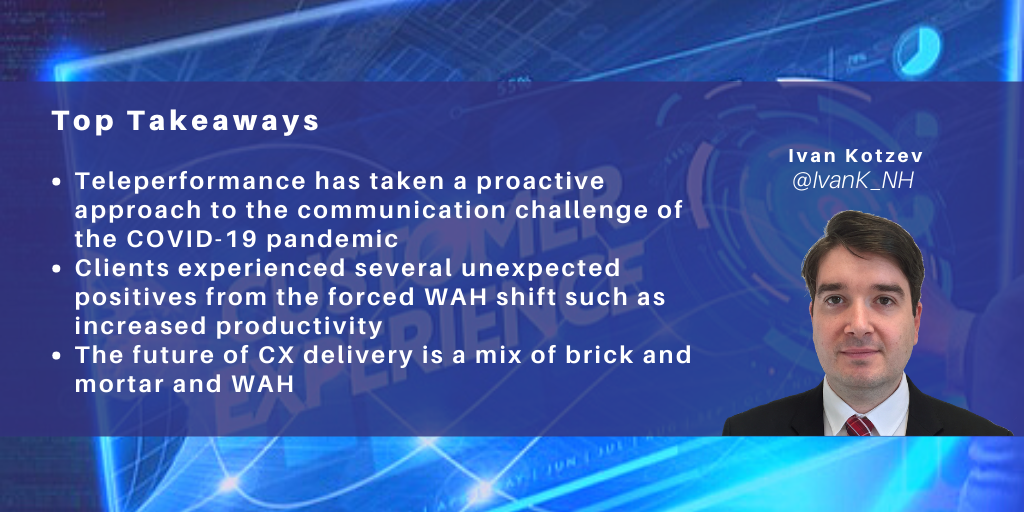Search posts by keywords:
Filter posts by author:
Related Reports
Related NEAT Reports
Other blog posts
posted on Jun 04, 2020 by Ivan Kotzev

The COVID-19 crisis is forcing a rethink of the CX delivery model with large contact centers. The fundamental question is how to maintain people’s health and safety in an open floor space with hundreds of seats, continuous face-to-face interactions, shared equipment, and 24x7 operations. For many outsourcing clients, the pandemic was the trigger to adopt work-at-home (WAH) for the first time. Two months later, these forced WAH pilots have their first results, and the emerging picture of a future CX work environment marks several changes.
In this post, I look at how Teleperformance is addressing the challenges of the pandemic and the next stages of their CX delivery plan in EMEA.
The pandemic is also a crisis of communication
The magnitude and speed of the pandemic and the resulting lockdowns at national, regional, and city level prompted Teleperformance to migrate 75% of its ~70k frontline workforce in EMEA to WAH in four weeks. It also reorganized the remaining contact centers under new health and safety policies. For each EMEA country, Teleperformance worked with clients to adapt the schedule to the local regulations such as curfews in Albania, Egypt, Lebanon, Madagascar, and lockdowns in Tunisia.
One of the less discussed challenges of the crisis is a general lack of reliable information and direction. Based on the experience of its Chinese operations, in March, Teleperformance issued global guidelines and a health and safety dashboard and began measuring regularly. It also organized bulletin boards, weekly newsletters, and daily CEO chats in every country. The health and safety guidelines included detailed cleaning protocols, sanitization of workstations and equipment before each work shift, temperature checks, where legally allowed, physical distance markers in offices and recreational spaces, availability of disinfectants and gels, closure of some common areas such as training and breakrooms, and opening of isolation rooms at every site. In some locations, the company also has an onsite physician to check symptoms and prescribe quarantining of individuals and teams. The company also procured six million face masks for its employees.
For the migration to WAH, Teleperformance prepared e-learning modules for the agents on working from home with recommendations on setting up the workspace, time management, and the importance of taking breaks. It also included tips on separating work and personal environments. For the managers, the modules focused on remote management, with team and one-on-one communication and some additional skills such as technical support.
(Un)expected effects of the WAH transition
For Teleperformance, the transitioning of processes to the WAH environment brought some expected and unexpected benefits. Not surprisingly, it had a massive drop in employee attrition rates, but it also experienced a 50% lower absenteeism even compared to before the pandemic. While the AHT increased, productivity improved and NPS and CSAT scores remained stable. The company is now running an employee survey to evaluate sentiment and satisfaction with the transition, and gauge interest in continuing to work from home. The initial feedback points to a large proportion of agents willing to go back to the call centers.
One of the biggest challenges of WAH delivery is engaging employees and alignment with the supported brand. Teleperformance EMEA benefited from moving experienced agents with classroom training and already immersed in the brand culture and values.
The company HR is addressing this distancing with several initiatives. It started virtual Zumba, yoga, and cooking classes, weekly happy hours, and lunch breaks with the CEO. New hire recruitment moved completely online and over video, bringing a higher attendance rate. It is also piloting fully virtual classroom training in Germany using Blackboard.
In May, it unified these capabilities under Teleperformance cloud campus with virtual talent acquisition, training, development, coaching, team building, learning, client interaction, quality control, and data security management, as well as social interaction for employees.
The future of CX is a mix of brick-and-mortar and WAH
Clients reacted with different speeds and agility to the crisis, with proactive organizations partnering with Teleperformance to quickly activate BCP and move agents and equipment to the home in the early days of March. Other clients, for example in BFSI, delayed decisions until mid-April, often awaiting inputs from their internal IT functions.
With the easing of movement and lockdown restrictions in certain European countries, CX services clients are opening discussions with Teleperformance to return to brick-and-mortar operations. However, this return faces far more questions than the initial WAH shift. For example, how to organize the contact center under social distancing rules, plus the question of whether the additional costs make it sustainable. Teleperformance EMEA calculated that a full return to physical centers with social distancing requires 2.5x its existing office space. The other big risk is the medical uncertainty and potential new wave of infections later in the year.
Regardless of any medical developments, the future of CX delivery will be a combination of on-site and remote working. Teleperformance is now planning for the partial return to brick-and-mortar operations with logistics steps, infrastructure changes, and floor changes such as workstation separators to comply with social distancing guidelines.
The new hybrid model is a must-have for risk mitigation, but it also opens opportunities for multilingual delivery in EMEA with cross-border access to talent. Teleperformance’s experience shows certain markets such as Egypt and Romania have a strong appetite and capability for WAH. The crisis also shifts other aspects of the industry, such as sales, where Teleperformance EMEA adopted virtual pitches and site visits.
Managing a distributed workforce entails a redesign of many CX operational processes, from different ways of organizing training content and teaching, to the recruitment of candidates specially selected to work remotely. The main objective now is negotiating with clients to reach a healthy balance of brick-and-mortar and WAH.
